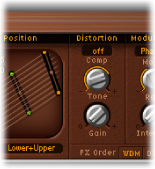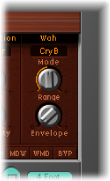Working with the EVD6 Integrated Effects
No clavinet simulation would be complete without a selection of effect processors. The EVD6 incorporates three “classic” foot-pedal effect emulations: distortion, modulation, and wah wah. Each effect was painstakingly modeled on pedals that were available in the heyday of the Clavinet—the 1970s—delivering that authentic, vintage sound in your performances.

- FX Order buttons: The EVD6 effects work in series—where the output of one effect is fed into the next effect processor in the effects chain. You can determine the order of the serial effects combination with the FX Order buttons. The routing choices are:
- WDM: Wah > Distortion > Modulation
- DWM: Distortion > Wah > Modulation
- MDW: Modulation > Distortion > Wah
- WMD: Wah > Modulation > Distortion
- BYP: Click the BYP button to bypass all effects. Click the button a second time to return to the previously selected effects routing.
Note: The assignable effect routing is especially useful for choosing whether a distorted signal should be wah-filtered (for funkier sounds) or the wah-filtered sound should be distorted (for screaming sounds)—as an example.
Using the EVD6 Distortion Effect
The Distortion effect integrates a Compressor effect, which always precedes the Distortion effect. This allows you to increase or decrease the perceived gain, thus providing the desired input level to the distortion circuit.

- Gain knob: Alters the level of the Distortion.
Use of low Tone and Gain settings creates warm overdrive effects.
High Tone and Gain settings results in bright, screaming distortion effects.
If Gain is at the minimum value, no distortion will be heard (but Compression may be, if active).
Note: Given the link between the Compressor and Distortion effect, the FX Order parameter is very important for placement of the Compressor in the effects chain. If Compressor/Distortion is the last effect in the chain—with the Gain knob turned down, but a high Compression Ratio—you will effectively compress the output signal of the EVD6.
Using the EVD6 Modulation Effect
The EVD6 features a choice of three modulation effect types: Phaser, Flanger, or Chorus. See the Modulation section of the Logic Pro Effects Help for further information on how these effects work.

- Intensity knob: Adjusts the depth of the phasing, flanging, or chorus effect.
When the Phaser effect is active, high Rate and Intensity values lead to very deep, self-oscillating phase shifts, for those cutting sounds—which can also damage ears and speakers, so be careful!
Use of high Intensity values lead to ensemble-type effects when the Chorus effect is active.
Using the EVD6 Wah Wah Effect
The name wah wah comes from the sound it produces. It has been a popular effect (usually a pedal effect) with electric guitarists since the days of Jimi Hendrix. The pedal controls the cutoff frequency of a bandpass, lowpass, or—less commonly—highpass filter. Wah wah pedals are also used extensively with the D6. The EVD6 offers simulations of several classic wah wah effects, as well as some basic filter types.

- Mode pop-up menu: Choose one of the following Wah Wah effect settings:
- Off: Wah Wah effect is disabled.
- ResoLP (Resonating Lowpass Filter): In this mode, the Wah Wah will work as a resonance-capable lowpass filter. At the minimum pedal position, only low frequencies can pass.
- ResoHP (Resonating Highpass Filter): In this mode, the Wah Wah will work as a resonance-capable highpass filter. At the maximum pedal position, only high frequencies can pass.
- Peak: In this mode, the Wah Wah will work as a peak (bell) filter. Frequencies close to the cutoff frequency will be emphasized.
- CryB: This setting mimics the sound of the popular Cry Baby wah wah pedal.
- Morley 1: This setting mimics the sound of a popular wah wah pedal, manufactured by Morley. It features a slight peak characteristic.
- Morley 2: This setting mimics the sound of the Morley distortion wah wah pedal. It has a constant Q(uality) Factor setting.
- Envelope knob: Determines the sensitivity of the (filter) envelope to incoming note velocity messages. An auto wah effect is produced by using the built-in envelope follower function, which controls the depth of filter cutoff modulation. In practical terms, this means that the dynamics of your performance directly control the depth of the Wah Wah filter modulation.